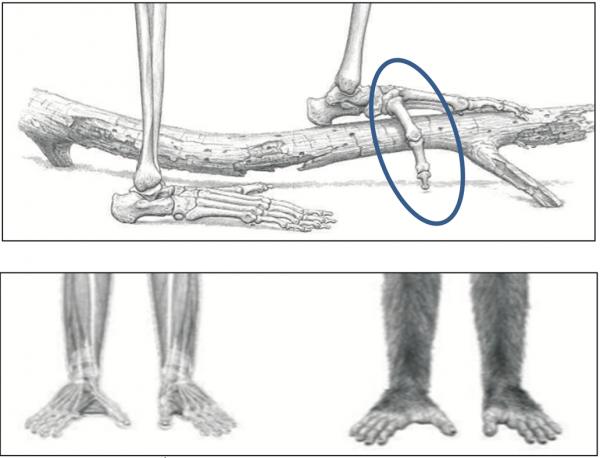Natural history museums everywhere display a line-up of ape-to-human icons that supposedly show how humans evolved from ape-like creatures millions of years ago. Ardipithecus ramidus, or “Ardi” is one of these famous icons, supposedly holding the “4 to 5 million years ago” time slot. Ardi is proudly displayed on the front cover of Science journal and school textbooks as if paleo experts are certain she holds a place in the evasive ape-to-human progression.


Did they find this complete skeleton as shown on the cover of the Science journal? Actually, no. This skeleton was reconstructed from over 110 bone pieces they found scattered over a 30-foot area, and it took them over a decade to put it together.[iii] This picture is only a digital reconstruction of what they found. What they actually found were bone pieces they said were in “terrible condition” and “literally crumbled” when touched. Their lead scientist said Ardi was like “road kill.”[iv]
Let’s look at Ardi from head to toe. Her skull was found in 34 pulverized, scattered pieces that were compacted down to about one-and-a-half inches thick.[v] The skull of this tiny ape can fit into the palm of your hand like a softball and her brain was about the same size as bonobo or a female chimp.[vi]

The researchers described the skull in their Science (2009) paper as “highly fragmented and distorted…many [recovered elements] were partially disintegrated by the silty clay sediment, and major structures were fragmentary and variably distorted.” Due to its fragile condition the skull could not be pieced together physically and so its reconstruction was approximated digitally.
Evolutionists have actually claimed that Ardi walked upright like humans, partially basing this idea on a few pieces of the base of her skull. But note that they are actually missing most of her foramen magnum, the hole where the spinal cord passes to the skull.[viii]

They also don’t even have the last couple neck vertebrae that would have joined to the skull, relying on even more guesswork.[x] Evolutionists also claim Ardi walked upright because of a supposed “human-like curve” in her lower spine, called lumbar lordosis (see Figure 5). But how much of her lower spine did they find? Well—actually, none—so they estimated the curve of her spine based on her pelvis (see Figure 6).
Dr. Owen Lovejoy believes that her spine was probably long and curved like a human’s rather than short and stiff like a chimp’s, suggesting that she was an upright-walker.[xi] We have four curves in our spines to facilitate upright walking, but chimps have only a slight bend over their whole spine, making them better for walking on all fours.

Dr. Lovejoy based his belief about Ardi’s curved spine on Ardi’s reconstructed pelvis and his guess that Ardi had six lumbar vertebrae,[xiii] even when most apes have only three or four, and humans have five. But think about this—they don’t even have any of Ardi’s lumbar vertebrae. But this didn’t stop them from adding some imaginary ones, giving her a couple extra beyond what typical apes have, inserting an entirely imaginary spine—complete with a four-part curve like humans—and passing it up to the reconstructed base of her skull using imaginary neck vertebrae.
Even evolutionary scientists have great concerns about these speculations. In their paper published in Nature, Drs. Wood and Harrison stated: “The claim that Ardi was a facultative terrestrial biped [living in trees and also walking upright on the ground] is vitiated because it is based on highly speculative inferences about the presence of lumbar lordosis and on relatively few features of the pelvis and foot.”[xiv]
So, if they’re also basing the belief that she walked upright on her pelvis, what was her pelvis like? Well, for starters, it was too badly broken and fragile to take out of the matrix it was in, so Dr. Lovejoy made a reconstruction based on his knowledge of primate anatomy and a Micro CT scanner. After 14 different possible configurations, they settled on the one shown in most reports.[xv] Secular paleo-experts Drs. Wood and Harrison also expressed a great deal of concern about this—pointing out in a science journal that a whole lot of speculation went into the final pelvis reconstruction.[xvi] Dr. Jungers even said that choosing the “correct” pelvis reconstruction was like seeing images in an Rorschach inkblot test and was not convinced of its accuracy.[xvii]

Even Ardi’s hands and feet looked ape-like, with really curved, long fingers and short thumbs, which are very similar to tree-dwelling apes of today that use them for getting around in trees. Her feet even had a grasping toe hanging off to the side (called a hallux), just like apes have today so they can use their feet like hands for grabbing branches while moving in trees (see Figure 7). Dr. White said that her toe “… really doesn’t differ from apes, and that’s the surprising thing. It is fully apelike.” Wouldn’t that be awkward—trying to walk on level ground with a big toe sticking out to the side?

It sure doesn’t add up that she’s some early human ancestor: Ardi had a brain the size of a chimp, in a tiny head like a chimp’s, with an imagined base of the skull and imagined, curved spine, but because of a bump on her pelvis, she was supposedly walking around like a human, with her giant toe sticking out to the side? And her hands were also ape-like. It looks like there’s a lot of speculation going on here, and in some cases even exaggeration! It doesn’t look like she’d be a good walker, but she’d probably get around in the trees just fine! When you put her next to a Bonobo, it sure seems like she fits into the ape family quite well (see Figure 8).

[i] December 18, 2009 edition.
[ii] Image credit: Wikipedia (https://en.wikipedia.org/wiki/Ardi#/media/File:Ardipithecis_Ramidus_skeleton_1994-1996.jpeg).
[iii] White, Tim, et al. “Ardipithecus ramidus and the Paleobiology of Early Hominids.” Science Vol. 326, Issue 5949 (October 2, 2009): 64–86.
[iv] Discovery team leader, Tim White, described Ardi’s remains as “road kill.” Gibbons, A. “A new kind of ancestor: Ardipithecus unveiled.” Science 326 (2009): 36–40.
[v] “Discovering Ardi.” Discovery Channel. March 30, 2010. (at 34 minutes)
[vi] Suwa, G. et al., “The Ardipithecus ramidus skull and its implications for Hominid origins.” Science 326 (2009): 68, 68e1–68e7.
[vii] Fig. 1 from Suwa, 2009 (ibid). The fragmented skull of ARA-VP-6/500. (Upper panel) Identifiable pieces of the skull after limited refitting for digital and physical molding. (Lower panel) (A) ARA-VP-6/500-032, (B) micro-CT rendered image of the same, with cross-sectional locations of (C) and (D) indicated. Arrowheads in (A) denote the positions of (C) and (D).
[viii] Suwa, 2009, 5949.
[ix] Fig. 2 from Suwa, 2009 (ibid). Digital representations of the Ar. ramidus cranium and mandible.
[x] Been, Ella (Editor), Gómez-Olivencia, Asier (Editor), Kramer, Patricia Ann. Spinal Evolution: Morphology, Function, and Pathology of the Spine in Hominoid Evolution. Springer (August 8th 2019): 276.
[xi] Gibbons, A., “A New Kind of Ancestor: Ardipithecus Unveiled.” Science NewsFocus 326 (2009): 36–40.
[xii] D’Août, K. “Evolution of the Vertebral Column” In: van de Kelft E. (eds) Surgery of the Spine and Spinal Cord. Springer, Cham., 2016.
[xiii] “Un gran paso hacia la humanidad” (entrevista a Owen Lovejoy) (Interview with Owen Lovejoy). Posted October 16, 2010. The new Evolutionary Enlightenment. https://ilevolucionista.blogspot.com/2010/10/un-gran-paso-hacia-la-humanidad.html. Accessed September 23, 2020. Relevant quote: “Although most of her sacrum and lumbar vertebrae were not recovered, parts of both lateral halves of Ardi’s pelvis were.”
[xiv] Wood, B. & Harrison, T. “The evolutionary context of the first hominins.” Nature 470 (2011): 347–352.
[xv] “Discovering Ardi.” Discovery Channel (March 30, 2010).
[xvi] Stanford, C.B. “Chimpanzees and the behavior of Ardipithecus ramidus.” Annual Review of Anthropology 41 (2012): 139–149.
[xvii] Jungers comments in an article in Archeology Magazine, “That’s [the digital reconstruction of Ardi’s hip] really kind of a 3-D Rorschach test if you ask me. I am still not convinced that it’s necessarily completely accurate.” See: Zorich, Z. “Ardipithecus: ape or ancestor?” Archaeology Magazine 63 (1), 2010.
[xviii] Image credit : Wikipedia: https://en.wikipedia.org/wiki/Ardi#/media/File:Ardipithecis_Ramidus_skeleton_1994-1996.jpeg.
[xix] News Focus. “A new kind of ancestor: Ardipithecus Unveiled.” Science (October 2, 2009). Restorations by artist Jay Matternes.
[xx] Ibid.









